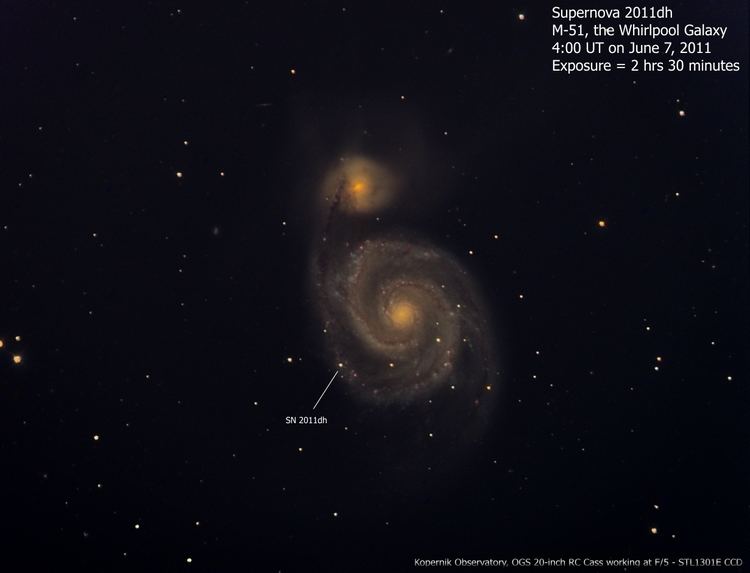Other designations SN 2011dh Spectral class IIb Right ascension 13 30 05.08 | Date 31 May 2011 Declination +47° 10′ 11.2″ | |
 | ||
Similar SN 1993J, SN 2005cs, Whirlpool Galaxy, NGC 5195, SN 2008D | ||
SN 2011dh is a supernova in the Whirlpool Galaxy (M51). On 31 May 2011 an apparent magnitude 13.5 type II supernova (the explosion of a single massive star) was detected in M51 at coordinates 13:30:05.08 +47:10:11.2. It was discovered by Tom Reiland; Thomas Griga; Amédée Riou; and Stephane Lamotte Bailey and confirmed by several sources, including the Palomar Transient Factory. A candidate progenitor has been detected in Hubble Space Telescope images at coordinates 13:30:05.119 +47:10:11.55. The progenitor may have been a highly luminous yellow supergiant with an initial mass of 18-24 solar masses. The supernova appears to have peaked near apparent magnitude 12.1 on 19 June 2011.
Emission spectra from W. M. Keck Observatory, obtained by Palomar Transient Factory indicate that this is a type II supernova with a relatively blue continuum with P Cygni profiles in the Balmer series. This is a unique event, because it occurs in a galaxy that is imaged almost constantly. It is expected to be observable for northern hemisphere observers for several months.
This is the third supernova to be recorded in the Whirlpool galaxy in 17 years (following SN 1994I and SN 2005cs) which is a lot for a single galaxy. The galactic supernova frequency is estimated to be around one event every 40 years.
Observing
In terms of visual stargazing with a large amateur telescope, this object may not jump out at the viewer. As of June 25, 2011, it was holding reasonably steady at magnitude 12.7. At that time, the supernova was about 300 times fainter than the naked eye magnitude of 6.5. The supernova is an easy target for an amateur telescope equipped with a modern CCD camera under a dark sky.
